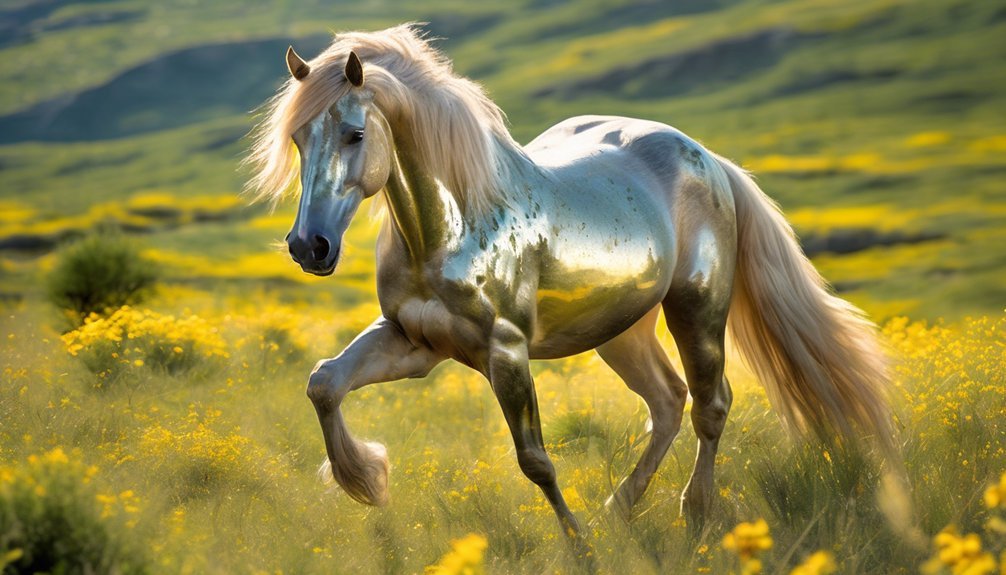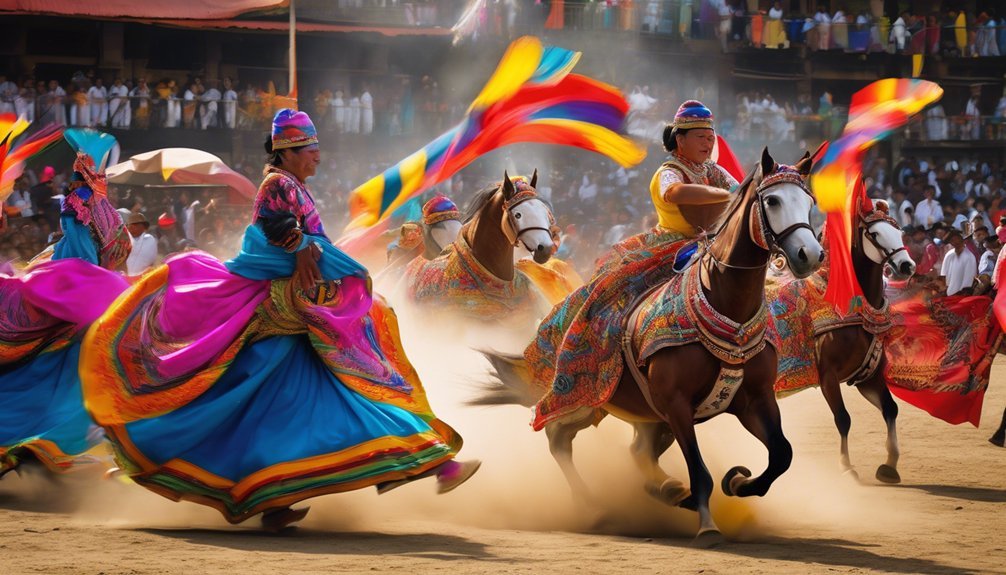
In a sun-drenched pasture, a group of horses stands together, their bodies swaying gently as they communicate with subtle movements and soft whinnies. You might wonder how these majestic animals navigate their social world, relying on intricate herd dynamics to thrive. From grooming rituals to complex hierarchies, each interaction shapes their emotional and physical well-being. What unseen forces guide their behaviors and decisions, and how do these elements contribute to their survival?
Key Takeaways
- Horses rely on social structures for survival, fostering emotional support and protection within their herds.
- Grooming rituals among horses strengthen social bonds and establish hierarchy, enhancing community cohesion.
- Dominant horses control resources, while subordinate members adapt behaviors to access essential grazing and watering spots.
- Collective decision-making occurs through non-verbal communication and vocalizations, ensuring group consensus without a single leader.
- Play behavior is vital for developing social skills and alleviating stress, contributing to the overall emotional health of the herd.
The Importance of Herd Structure
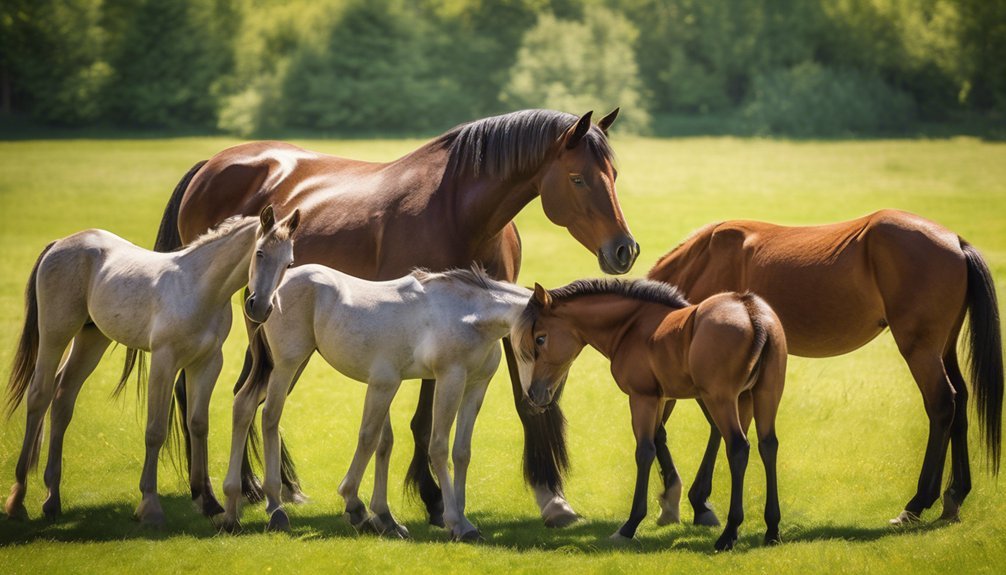
When you observe a group of horses in the wild, you quickly notice that their social structure plays a crucial role in their survival and well-being.
The importance of herd stability becomes evident as you watch them interact, reinforcing social cohesion through mutual grooming and close proximity. Each horse contributes to the group's dynamics, creating a sense of security that fosters trust and cooperation.
You'll see how they rely on one another, whether for protection against predators or for emotional support during stressful times. This intricate web of relationships not only enhances their chances of survival but also enriches their lives.
Understanding this structure deepens your appreciation for these majestic creatures and their remarkable ability to thrive together.
Social Hierarchies and Roles
As you observe a herd of horses, you might notice the intricate web of dominance and submission that shapes their social dynamics.
Each horse plays a crucial role, from the leaders guiding the group to those seeking safety in more submissive positions.
Grooming behaviors and territorial disputes further illustrate how these roles influence not just individual relationships but the overall stability of the herd.
Dominance and Submission Roles
Understanding the intricate dynamics of dominance and submission roles among horses reveals much about their social hierarchies. You might observe:
- Dominance Displays: Strong postures and assertive movements signal authority.
- Submission Behaviors: Lowered heads and retreating actions indicate acceptance of a lower rank.
- Power Struggles: Frequent challenges can lead to intense interactions as horses assess dominance.
- Leadership Dynamics: A horse's ability to lead relies on trust building and conflict resolution.
These roles aren't static; they shift with social challenges and role transitions.
Hierarchy shifts can emerge during conflicts, revealing the delicate nature of relationships. Each interaction serves as a dominance assessment, showcasing the complexity of trust and authority in the herd.
Observing these nuances deepens your understanding of their world.
Grooming and Bonding Behavior
While grooming may seem like a simple act of cleaning, it plays a crucial role in building and maintaining social bonds within a horse herd.
You'll notice how horses engage in intricate grooming rituals, often choosing specific companions to share this intimate act. As they nibble at each other's coats, they're not just removing dirt; they're reinforcing trust and affection.
This behavior strengthens their social hierarchy, as dominant horses often initiate grooming, signaling their leadership. Yet, even lower-ranking members partake, showcasing a network of relationships that transcends mere rank.
Observing these interactions reveals a profound layer of social bonding, where each stroke and nibble deepens connections, allowing a sense of community to flourish within the herd.
Territory and Resource Control
Territory and resource control among horses is a fascinating dance of social dynamics that reflects their hierarchical structure.
You'll notice how these majestic beings navigate their space, often engaging in territorial disputes to establish dominance and control essential resources. Understanding their behavior can be enriching.
Consider these key aspects:
- Hierarchical Structure: Dominant horses claim prime grazing and watering spots.
- Resource Allocation: Subordinate members learn to adapt, often waiting for their turn.
- Conflict Resolution: Disputes are typically resolved through displays rather than physical confrontations.
- Group Cohesion: Maintaining balance is crucial; harmony promotes overall herd health.
Observing these intricate interactions can deepen your appreciation for their social lives, revealing the delicate balance of power and cooperation within the herd.
Communication Within the Herd
As you observe a herd of horses, you'll notice a rich tapestry of communication unfolding through their body language and sounds.
Each flick of an ear or swish of a tail conveys emotions and intentions, while their vocalizations add another layer to their interactions.
Understanding these non-verbal signals and vocal cues reveals how they maintain harmony and structure within the group.
Non-verbal Signals
Understanding the non-verbal signals within a horse herd reveals the intricate web of communication that shapes their social dynamics.
You'll notice how these majestic creatures express themselves through various subtle cues that convey feelings and intentions.
Pay attention to:
- Body Language: A horse's posture can indicate confidence or submission.
- Eye Contact: Direct gazes often signify challenge, while avoiding eye contact shows deference.
- Ear Positioning: Forward ears signal curiosity, while pinned ears denote irritation or warning.
- Tail Movements: A swishing tail may indicate annoyance, while a relaxed tail suggests comfort.
These elements, along with movement patterns and social distance awareness, create a rich tapestry of communication, enhancing the bonds within the herd.
Observing these signals can deepen your connection with these remarkable animals.
Vocalizations and Sounds
While non-verbal cues play a significant role in herd communication, vocalizations add another layer of complexity to how horses interact with one another. You might observe distinct vocal patterns, each with its own sound meanings, revealing a rich tapestry of emotions and intentions.
Horses use various communication types, from soft whinnies to urgent herd calls, forming a symphony of auditory signals that convey messages. Emotional vocalizations can indicate distress, contentment, or even excitement, showcasing their nuanced vocal behavior.
As you witness these horse noises, notice how sound recognition among individuals enhances their bond, fostering a deeper understanding within the herd. This intricate vocal communication not only strengthens relationships but also ensures the herd's cohesion in its dynamic environment.
Bonding and Relationships Among Horses
Horses form intricate bonds within their herds, revealing a social structure that's both complex and fascinating.
You'll notice how they engage in various bonding rituals that foster emotional connections and enhance herd cohesion.
Key aspects of these relationships include:
- Mutual Grooming: This behavior serves as a trust-building activity, reinforcing friendships.
- Play Interactions: Horses often engage in playful behaviors that strengthen companionship and establish attachment styles.
- Social Support: They provide comfort to one another during stressful situations, showcasing their deep emotional ties.
- Friendship Formations: Unique pairings develop, illustrating the importance of individuality in their social dynamics.
These elements highlight the profound emotional landscape among horses, emphasizing the importance of companionship behaviors in their lives.
The Impact of Environment on Herd Dynamics
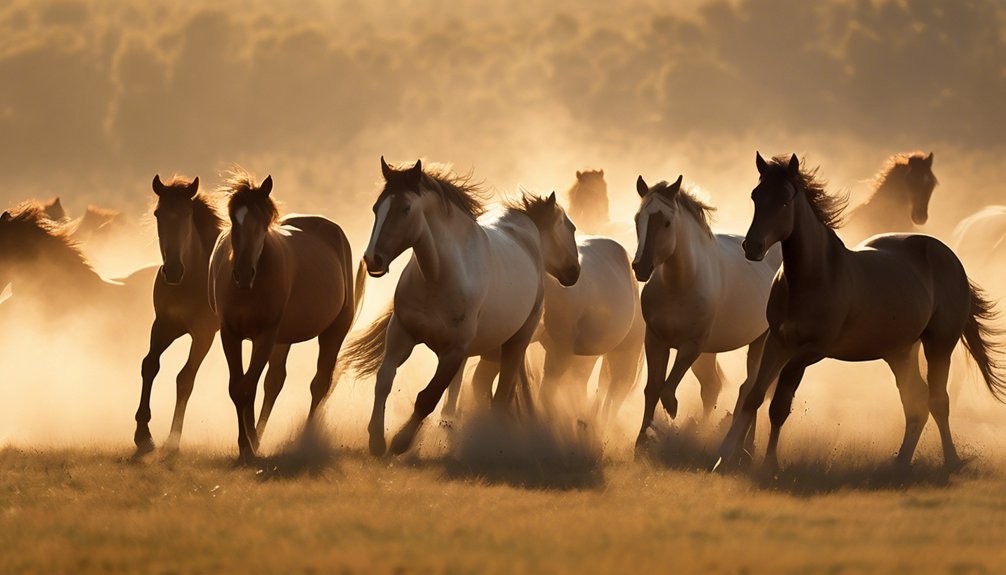
The environment plays a crucial role in shaping herd dynamics, influencing everything from social hierarchies to individual behaviors.
You'll notice that habitat diversity can foster a range of interactions among horses, as varying landscapes encourage different grazing patterns and social structures. Resource availability, especially in terms of water sources and food, directly impacts herd cohesion.
Seasonal changes can create challenges, forcing horses to adapt their behaviors and social roles to find shelter or sustain their energy. Weather impacts, like harsh winds or rain, can further modify how horses interact—some may huddle together for warmth while others seek solitude.
Decision-Making Processes in Groups
When observing a herd, it's fascinating to see how decisions are made collectively, often without any single leader imposing their will.
Horses exhibit remarkable group consensus through various decision-making strategies. Here are key elements influencing their collective behavior:
- Information Sharing: Members communicate their observations, creating a shared understanding.
- Social Influence: Stronger or more experienced horses often guide the group's choices, subtly shaping preferences.
- Leader Selection: Rather than a fixed leader, the group may shift leadership based on context and expertise.
- Conflict Resolution: When disagreements arise, horses utilize body language and vocalizations to navigate tensions, ensuring harmony.
Through these processes, they assess risks and adapt, showcasing a sophisticated system of decision-making that emphasizes cooperation and unity.
The Role of Play in Social Learning
While observing a group of horses at play, you can see how vital this behavior is for social learning. Their play behavior isn't just for fun; it's a crucial part of developing social skills.
As they chase each other, you notice the subtle exchanges of body language—signals of trust and challenge. These interactions teach younger horses about boundaries and cooperation, fostering relationships within the herd.
You might see a foal mimic the actions of older horses, learning the nuances of social dynamics through trial and error. Each playful encounter builds confidence and reinforces bonds.
This lively dance of interaction isn't merely instinctual; it's fundamental for establishing a cohesive community where every member thrives.
Understanding Stress and Well-Being in Herds
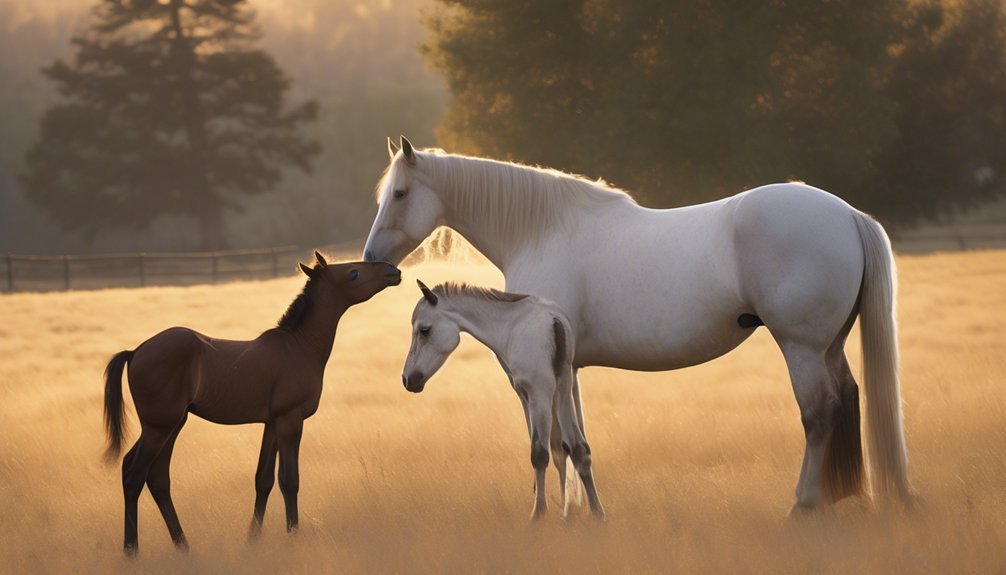
Understanding the stress levels within a herd reveals much about their overall well-being. By observing stress indicators, you can glean insights into their emotional health and herd stability.
Here are some key aspects to consider:
- Environmental Stressors: Changes in surroundings can trigger anxiety behaviors in horses.
- Social Stress Management: How horses interact can either alleviate or heighten stress within the group.
- Coping Strategies: Effective herd resilience often relies on shared coping mechanisms during stressful times.
- Behavioral Observations: Noticing subtle shifts in behavior can be crucial for addressing anxiety and enhancing herd well-being.
Frequently Asked Questions
How Do Horses Choose Their Leaders in a Herd?
When observing horses, you'll notice leader selection often hinges on social interactions. Through subtle displays of confidence and strength, individuals establish a dominance hierarchy, guiding the herd's structure and influencing group dynamics effectively.
Can Horses Form Friendships Outside Their Herd?
Yes, horses can form friendships outside their herd. You'll notice their social bonding extends to cross species friendships, showcasing their emotional depth and ability to connect with others, enriching their experiences beyond familiar companions.
What Are Common Signs of Stress in a Horse Herd?
When observing a horse herd, you'll notice stress behaviors like pacing, vocalizations, or pinned ears. These signals indicate herd communication issues, revealing deeper tensions that could impact their overall well-being and social structure.
How Does the Age of Horses Affect Herd Dynamics?
You'll notice young horses often challenge social hierarchies, creating instability. As horses age, their wisdom fosters herd stability, guiding younger members. The aging effects promote balance, allowing for a harmonious coexistence within the group.
Do Horses Recognize Individual Humans Within Their Herd Environment?
Imagine a tapestry woven with threads of connection. Horses do recognize individual humans, forming social bonds that reflect their understanding. Your presence resonates with them, creating a unique relationship that transcends mere familiarity, enriching their lives.
Conclusion
In the vibrant world of horses, herd harmony hinges on hidden hierarchies and heartfelt connections. You witness the way they nuzzle and nicker, communicating with captivating clarity. Observing their playful prancing reveals the profound power of social bonds, fostering trust and resilience. By understanding stress signals and supporting their structures, you can help maintain their well-being. Ultimately, nurturing these dynamic relationships is essential for ensuring each horse thrives, creating a cohesive community grounded in care and companionship.




